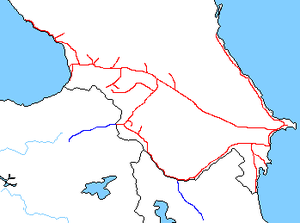Transcaucasus Railway
| Transcaucus Railway | |
|---|---|
 The railway in 1986 (Former lines in Blue) | |
| Locale | Caucasus, northeast Turkey |
| Dates of operation | 1865–1991 |
| Successor | TCDD, RZhD, IRIR, ADDY, GR, HYU, AKR |
| Track gauge | 1,520 mm (4 ft 11 27⁄32 in) |
| Headquarters | T'bilisi |
The Transcaucus Railway (Russian: Железная дорога совещания, Turkish: Kafkas Demiryolu) was the first railway in Caucasia. It was funded by the Russian Empire as a strategic railway connecting the Black Sea to the Caspian Sea. Caucasia was a land disputed between the Russian Empire and the Ottoman Empire. The railway would allow the Russian army to have better control of Caucasia. Also with the Trans-Caspian railway, Russia could transport troops from Central Asia much faster. The railway operated as a private company between 1865–1922 and a subsidiary railway of the Soviet Railways from 1922-1991.
History
Russian Empire (1865-1917)

Russian Civil War (1918-1922)
With the dissolution of the Russian Empire, a 147 km part of the Julfa-Tabriz line was acquired by the Islamic Republic of Iran Railways. The Ottoman Empire lost, along with the Central Powers, giving northeastern Anatolia to Armenia. In 1919 the Turkish War of Independence broke out and northeastern Anatolia was taken back by the Turks, this time as the Republic of Turkey. The Treaty of Gümrü was signed on December 2, 1920 setting the present day borders of Turkey. The Transcaucasus Railway continued to operated the 404 km part of its system in Turkey. In 1921 the Erzurum-Yeniköy section of the line was abandoned.
Soviet Union (1922-1991)
The Soviet Union was formed in 1922, and the Transcaucasus Railway was absorbed by the Soviet Railways but continued to operate as a subsidiary railway. In 1924 the railway started building a line from Baku, south to Alyat, Shirvan and to the port city of Neftchala. In 1927, the Akyaka-Erzurum (in Turkey) section of its system was acquired by the Turkish State Railways. The railway built a branch line from Gyumri to Maralik in 1925. the railway built a line north to connect with the Soviet Railways at Adler branching off at Senaki, the line was completed to Gali in 1930, Sukhumi in 1938 and Adler in 1949. A branch line to Tkvarcheli was built in 1940. A line from Kutaisi to Tskhaltubo was built in 1935 along with a branch to Tskhinvali in 1940. In 1941 the railway built two lines: one from Shirvan to Julfa and one from Salyan to Astara on the Azerbaijan-Iran border, thus connecting with the Iranian system. A line was built to the port city of Batumi was later built in the 1960s.
Dissolution of the Railway (1991)
After the dissolution of the Soviet Union the railway was divided among the new countries that were formed. Jalama-Makhachkala part of the Baku-Makhachkala line was acquired by the Russian Railways. The tracks in Georgia were acquired by the Georgian Railways LLC, although the tracks in Abkhazia were taken over by the Abkhazian railway (this company was later absorbed by the Georgian railways). The tracks in Azerbaijan and Nakhchivan were taken over by the Azerbaijan State Railway and the tracks in Armenia were taken over by the Armenian Railway.
The railway Tbilisi-Baku (in Georgia and Azerbaijan) is being renovated during 2008-2014, together with a new railway built between Turkey and Tbilisi, Georgia. This is the Kars–Tbilisi–Baku railway. There is a closed railway Tbilisi-Armenia-Turkey but Armenia will be bypassed by this project.
External links
| |||||||||||